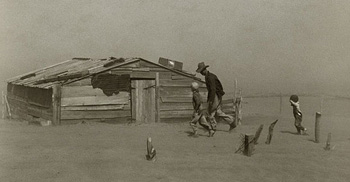Wind Erosion
The Dust Bowl storms of the 1930s were an extreme example of erosion by wind. Like water, wind can be a powerful agent of soil erosion. Wind erosion occurs by one of three main processes:

- Saltation: sand-sized particles are blown into the air, travel a short distance, then dislodge more soil as they fall back to the ground
- Suspension: very fine particles are lifted into the air by the effects of saltation. They can remain suspended high in the air for long periods of time and travel great distances
- Surface creep: the movement of large soil particles along the ground’s surface after being loosened by the effects of saltation.

This first-hand account of a Dust Bowl storm was recorded in 1940. In it Mrs. Flora Robertson tells what it was like to have the sun disappear for a week at a time because of huge clouds of soil blowing over her home. |
The Dust Bowl storms were largely attributed to wind erosion by suspension. These storms were characterized by very fine soil particles that traveled great distances. They were caused when farmers left their fields bare during the non-growing season, which made the soil very vulnerable to wind erosion.
Where do you think wind erosion is most common?
Wind erosion is most common in areas with dry sandy soil that has been exposed. Plants protect the soil from wind erosion, but in areas where the plants have been removed, the soil is especially vulnerable to erosion.